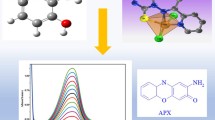Abstract
A selection of cobalt (III)/(II) macrobicyclic ‘sarcophagine’ (sar) cage complexes with N3S3 mixed donor sets but differing in a single apical substituent has been chosen to span a redox potential range of +150 to −150 mV vs the normal hydrogen electrode and thus acts as redox buffers in protein spectroelectrochemistry and redox potentiometry. The cobalt(III) cage complexes are all based on the same parent structure [Co(XMeN3S3sar)]3+, where X, the variable apical substituent, is –NO2, –Cl, –OH, –NH2, or –NMe +3 , and a methyl group occupies the opposite apical position. The X-ray crystal structures of selected members of this series are reported. Changes to the apical substituent X enable the CoIII/II redox potential to be tuned across a range of more than 200 mV by the inductive effects of the functional group. The pH dependence of the redox potential enabled the pK a values of some functional groups to be determined. The complexes were successfully employed as electron transfer mediators in the spectroelectrochemical investigation of a variety of heme proteins.
Graphical abstract












Similar content being viewed by others
Abbreviations
- ORP:
-
Oxidation–reduction potential
- sar:
-
Sarcophagine
- Mb:
-
Myoglobin
- ReFixL:
-
FixL from Rhizobium etli
- Hb:
-
Hemoglobin
References
Léger C, Bertrand P (2008) Chem Rev 108:2379–2438. doi:10.1021/cr0680742
Wang J, Li M, Shi Z, Li N, Gu Z (2002) Anal Chem 74:1993–1997. doi:10.1021/ac010978u
Bernhardt PV (2006) Aust J Chem 59:233–256. doi:10.1071/CH05340
Bernhardt PV, Chen K, Sharpe PC (2006) J Biol Inorg Chem 11:930–936. doi:10.1007/s00775-006-0148-z
Chen K-I, McEwan AG, Bernhardt PV (2009) J Biol Inorg Chem 14:409–419. doi:10.1007/s00775-008-0458-4
Chen K-I, McEwan AG, Bernhardt PV (2011) J Biol Inorg Chem 16:227–234. doi:10.1007/s00775-010-0719-x
Kalimuthu P, Leimkühler S, Bernhardt PV (2012) J Phys Chem B 116:11600–11607. doi:10.1021/jp307374z
Chen K-I, Challinor VL, Kielmann L, Sharpe PC, De Voss JJ, Kappler U, McEwan AG, Bernhardt PV (2015) J Biol Inorg Chem 20:395–402. doi:10.1007/s00775-014-1215-5
Kalimuthu P, Heider J, Knack D, Bernhardt PV (2015) J Phys Chem B 119:3456–3463. doi:10.1021/jp512562k
Honorio Felício N, Carepo MSP, Paulo, T de F, de França Lopes LG, Sousa EHS, Diógenes ICN, Bernhardt PV (2016) J Inorg Biochem 164:34–41. doi:10.1016/j.jinorgbio.2016.08.009
Gahan LR, Harrowfield JM (2015) Polyhedron 94:1–51. doi:10.1016/j.poly.2015.03.036
Behm CA, Boreham PFL, Creaser II, Daszkiewicz BK, Maddalena DJ, Sargeson AM, Snowdon GM (1995) Aust J Chem 48:1009. doi:10.1071/CH9951009
Sargeson AM (1996) Coord Chem Rev 151:89–114. doi:10.1016/S0010-8545(96)90197-6
Di Bartolo NM, Sargeson AM, Donlevy TM, Smith SV (2001) J Chem Soc Dalton Trans 2303–2309. doi:10.1039/b103242a
Geue RJ, Hambley TW, Harrowfield JM, Sargeson AM, Snow MR (1984) J Am Chem Soc 106:5478–5488. doi:10.1021/ja00331a016
Geue RJ, Hendry AJ, Sargeson AM (1989) J Chem Soc Chem Commun 1646–1647. 10.1039/C39890001646
Lawrance GA, Lay PA, Sargeson AM (1990) Inorg Chem 29:4808–4816. doi:10.1021/ic00348a042
Bottomley GA, Clark IJ, Creaser II, Engelhardt LM, Geue RJ, Hagen KS, Harrowfield JM, Lawrance GA, Lay PA, Sargeson AM, See AJ, Skelton BW, White AH, Wilner FR (1994) Aust J Chem 47:143. doi:10.1071/CH9940143
Bruce JI, Lawrance GA, Hambley TW, Stranger R (1993) Inorg Chem 32:5997–6002. doi:10.1021/ic00078a016
Donlevy TM, Gahan LR, Hambley TW, Stranger R (1992) Inorg Chem 31:4376–4382. doi:10.1021/ic00047a027
Gahan LR, Hambley TW, Sargeson AM, Snow MR (1982) Inorg Chem 21:2699–2706. doi:10.1021/ic00137a033
Gahan LR, Lawrance GA, Sargeson AM (1984) Inorg Chem 23:4369–4376. doi:10.1021/ic00193a052
Armarego WLF, Chai CLL (2009) Purification of laboratory chemicals, 6th edn. Elsevier, Oxford, UK, p 136
Doering WVE, Levy LK (1955) J Am Chem Soc 77:509. doi:10.1021/ja01608a001
Lay PA, Lydon J, Mau AWH, Osvath P, Sargeson AM, Sasse WHF (1993) Aust J Chem 46:641. doi:10.1071/CH9930641
Bard AJ, Faulkner LR (2001) Electrochemical methods, fundamentals and applications, 2nd edn. Wiley, New York, USA
King P, Maeder M (2014) ReactLab Redox, a program for the analysis of Redox titration measurements. JPlus Consulting Pty Ltd, Perth, Australia
Sheldrick GM (2008) Acta Cryst Sect A 61:112–122. doi:10.1107/S0108767307043930
Farrugia LJ (1999) J Appl Crystallogr 32:837. doi:10.1107/S0021889899006020
Farrugia LJ (1997) J Appl Crystallogr 30:565. doi:10.1107/S0021889897003117
Osvath P, Sargeson AM, McAuley A, Mendelez RE, Subramanian S, Zaworotko MJ, Broge L (1999) Inorg Chem 38:3634–3643. doi:10.1021/ic981380g
Bernhardt PV, Bygott AM, Geue RJ, Hendry AJ, Korybut-Daszkiewicz BR, Lay PL, Pladziewicz JR, Sargeson AM, Willis AC (1994) Inorg Chem 33:4553–4561. doi:10.1021/ic00098a023
Harrowfield J (2006) Supramol Chem 18:125–136. doi:10.1080/10610270600552533
Bernhardt PV, Kim Y, Sujandi (2006) Aust J Chem 59:783–790. doi:10.1071/CH06257
Hambley TW, Snow MR (1986) Inorg Chem 25:1378–1382. doi:10.1021/ic00229a017
Creaser II, Geue RJ, Harrowfield JM, Herlt AJ, Sargeson AM, Snow MR, Springborg J (1982) J Am Chem Soc 104:6016–6025. doi:10.1021/ja00386a030
Clark WM (1960) The oxidation-reduction potentials of organic systems. The Williams and Wilkins Company, Baltimore, USA
Sousa EHS, Tuckerman JR, Gondim ACS, Gonzalez G, Gilles-Gonzalez MA (2013) Biochemistry 52:456–465. doi:10.1021/bi300991r
Scheller FW, Bistolas N, Liu S, Jänchen M, Katterle M, Wollenberger U (2005) Adv Colloid Interface Sci 116:111–120. doi:10.1016/j.cis.2005.05.006
Evans SV, Brayer GD (1988) J Biol Chem 263:4263
Spiro TG, Strekas TC (1974) J Am Chem Soc 96:338–345. doi:10.1021/ja00809a004
Eaton WA, Hanson LK, Stephens PJ, Sutherland JC, Dunn JBR (1978) J Am Chem Soc 100:4991–5003. doi:10.1021/ja00484a013
Taylor J, Morgan VE (1942) J Biol Chem 144:15–20
Song S, Dong S (1988) J Electroanal Chem Interfac Electrochem 253:337–346. doi:10.1016/0022-0728(88)87070-0
Acknowledgements
PVB acknowledges financial support from the Australian Research Council (DP150103345).
Author information
Authors and Affiliations
Corresponding author
Rights and permissions
About this article
Cite this article
He, F.M.C., Bernhardt, P.V. Cobalt cage complexes as mediators of protein electron transfer. J Biol Inorg Chem 22, 775–788 (2017). https://doi.org/10.1007/s00775-016-1427-y
Received:
Accepted:
Published:
Issue Date:
DOI: https://doi.org/10.1007/s00775-016-1427-y




